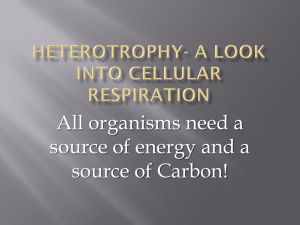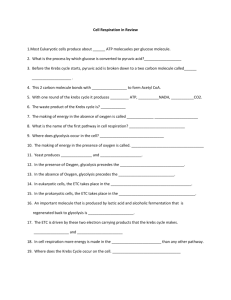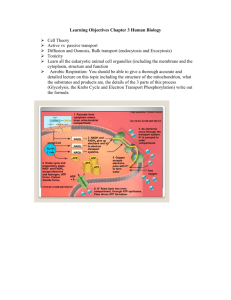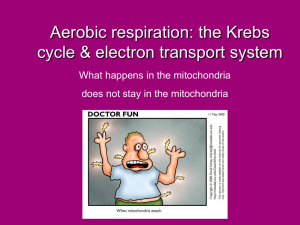Metabolism Review - CCBC Faculty Web
advertisement
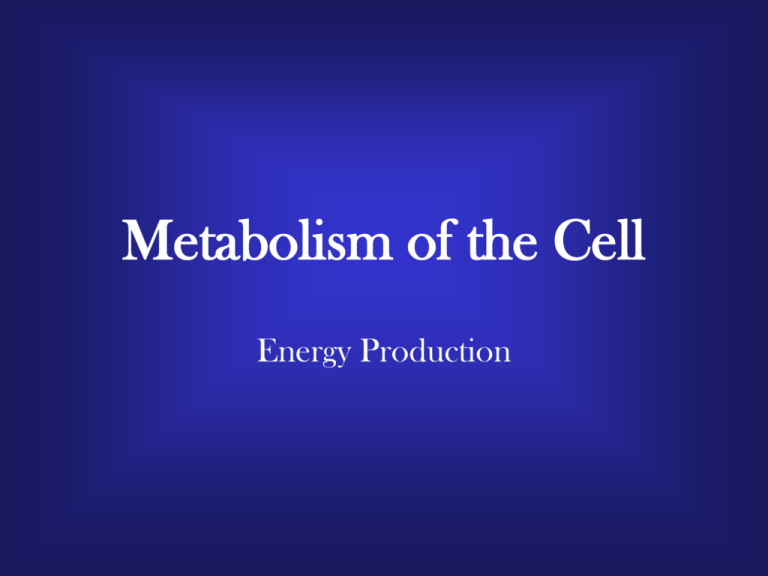
Metabolism of the Cell Energy Production Metabolism • Refers to “all chemical reactions necessary to maintain life”. • Anabolic processes (anabolism) build from smaller molecules – for example, building of proteins from amino acids – anabolic processes generally require energy input • Catabolic processes (catabolism) break down larger molecules into smaller ones. – for example, breakdown of glucose into carbon dioxide and water – catabolic processes generally release energy Cellular Respiration • Describes the series of reactions that break down glucose to release ATP. • Includes glycolysis, Krebs cycle, and oxidative phosphorylation within the electron transport system. Major Stages of Metabolism I. Glycolysis II. Krebs Cycle (a.k.a., tricarboxylic acid cycle, TCA cycle, citric acid cycle) III. Oxidative Phosphorylation Electron Transport System and Chemiosmosis • Digestion, the breakdown of food into usable molecules such as glucose, is required before metabolism can occur Metabolism Terms • ATP – Adenosine triphosphate - simplest storage form of cellular energy • Glucose – main substrate for ATP production; a monosaccharide (simple sugar). • NAD+ – coenzyme that accepts hydrogen; derived from niacin – NADH (more accurately – NADH+H+) reduced form of the coenzyme; includes two additional electrons and one hydrogen. • FAD+ – another coenzyme that accepts hydrogen; derived from riboflavin. – FADH2 – reduced form including two hydrogens and their electrons Metabolism Terms(cont.) • Oxidation - reactions within cellular respiration that occurs due to a loss of electrons (usually seen as hydrogen) or a gain in oxygen. • Oxidation-reduction (redox) reactions – coupled reactions in which one substance donates (loses) electrons (i.e., is oxidized) and another then gains those electrons (i.e., is reduced). • Reduction – reaction in which a substrate gains electrons (usually seen as hydrogen) Metabolism Terms(cont.) • Phosphorylation – addition of phosphate group to a molecule resulting in addition of energy to the molecule; e.g., ADP + Pi ATP – substrate-level phosphorylation – direct transfer from one molecule to another •e.g., bisphophoglycerate + ADP ATP + phosphoglycerate – moves phosphate from bisphosphoglycerate (which has 2 phosphates) to ADP to make ATP and phosphoglycerate (which has one phosphate) – oxidative phosphorylation – more complex method of ATP production involving electron transport chain (series of redox reactions) Glycolysis Glycolysis • Breakdown of glucose into pyruvic acid – Glucose comes from the food that we eat • Occurs in the cytoplasm of the cells • Results in a net production of 2 ATP and 2 reduced electron carriers (NADH) Glycolysis - Overview 3 Phases: •sugar activation •sugar cleavage •sugar oxidation and formation of ATP Fig. 25.6, p. 966 Phase 1 – Sugar Activation Glucose (6-carbon) gains phosphate (and energy) from each of two (2) ATP molecules and becomes an unstable 6-carbon molecule (fructose-1,6-diphosphate) • Adenosine triphosphate (ATP) becomes adenosine diphosphate (ADP) Fig. 25.6, p. 966 Phase Two – Sugar Cleavage DHAP G3P Unstable 6-carbon molecule, (fructose-1,6-diphosphate), is broken into 2 3-carbon molecules (DHAP and G3P) • no additional energy required Fig. 25.6, p. 966 Phase Three – Sugar Oxidation 2 3-carbon molecules (DHAP and G3P) are each oxidized resulting in release of energy used to make 4 ATP (2 from each) and formation of 2 pyruvate (1 from each) • ATP produced by substratelevel phosphorylation Fig. 25.6, p. 966 Phase Three – Sugar Oxidation (con’t) • oxidation of these 2 3-carbon molecules (DHAP and G3P) also results in formation of 2 molecules of NADH (one from each 3-carbon molecule), the energy from which will be used in the mitochondria during oxidative phosphorylation • when oxygen is present, pyruvate diffuses into the mitochondria for the next steps of cellular respiration • when oxygen is not present, pyruvate is reduced using the NADH and becomes lactic acid Glycolysis Energy Summary • Net ATP production = 2 – 4 produced – 2 used •two (2) ATP are utilized in phase 1, so 2 are subtracted from the total produced • 2 NADH produced total (one per G3P) – will be used in electron transport chain / oxidative phosphorylation in mitochondria when oxygen is present From Glycolysis to Krebs • Pyruvate created in glycolysis diffuses from the cell cytoplasm into the matrix of the mitochondria to be further broken down • Going from glycolysis to Krebs involves an intermediate step in which pyruvate is reduced and reworked into a 2-carbon molecule called acetyl-CoA by removing one CO2 group and addition coenzyme A; this also produces 1 molecule of NADH for each pyruvate Krebs Cycle Krebs Cycle • Begins when the acetyl group of acetyl-CoA combines with oxaloacetate (4-carbon molecule) to form citrate (6-carbon molecule) and release the CoA. • Remaining reactions involve oxidizing the molecule and regenerating oxaloacetate – reactions also produce carbon dioxide (CO2), which will be released from the cell; reduced electron carriers, which will be used in the next stage; and GTP, which can be used to produce an equivalent amount of ATP Fig. 25.7, p. 968 Krebs Cycle (con’t) • Each citrate is rearranged during this cycle to produce two (2) CO2 molecules, three (3) NADH, one (1) FADH2, and one (1) ATP. Fig. 25.7, p. 968 Acetyl-CoA and Krebs Cycle Energy Summary • ATP Production – One (1) per cycle of Krebs. • NADH Production – one (1) NADH created with the formation of Acetyl CoA – three (3) NADH created during Krebs cycle • FADH2 Production – One per cycle of Krebs • REMEMBER: Krebs goes through 2 times for each glucose that started the process Acetyl-CoA and Krebs Cycle Energy Summary • REMEMBER: Krebs goes through 2 times for each glucose that started the process, therefore, the total is: – 2 ATP created during the Krebs cycle – 2 NADH created with the formation of Acetyl CoA – 6 NADH created during Krebs cycle – 2 FADH2 created during Krebs cycle Total Energy Summary, Through Krebs Cycle From one (1) molecule of glucose: • 4 ATP – 2 (Glycolysis) + 2 (Krebs) • 10 NADH – 2 (Glycolysis) + 2 (Acetyl CoA formation) + 6 (Krebs) • 2 FADH2 – 2 (Krebs) Oxidative Phosphorylation Electron Transport System (ETS) and Chemiosmosis Electron Transport System • Utilizes the NADH and FADH2 produced in Glycolysis and Krebs. • Occurs in the inner membrane of the mitochondria. • Cannot occur without oxygen Electron Transport System Step 1 Molecules within the inner membrane of the mitochondria take the two (2) electrons from NADH and the two (2) from FADH2 and pass them from one to another. (i.e., redox reactions) Fig. 25.8, p. 969 Electron Transport System Step 2 • The transfer of electrons moves hydrogen atoms (H+) into the intermembrane compartment of the mitochondrion. Fig.Fig. 25.8, 25.8, p. p. 969969 Electron Transport System Step 3 • When enough H+ atoms collect in the compartment, they travel down their concentration gradient into the mitochrondrial matrix in a process called chemiosmosis. • Movement occurs through ATP synthase enzyme that uses the energy of H+ movement to create ATP from ADP Fig. 25.8, p. 969 Electron Transport System Step 4 • Once the electrons have moved to the end of the molecules in this chain, two(2) electrons combine with one (1) oxygen atom (formed from the breakdown of molecular oxygen, or O2) and two (2) hydrogen atoms to make water. • Oxygen is a KEY component to this process. – If oxygen is not present to combine and make water, then the electron transport system backs up, no H+ atoms are released and ATP cannot form. – Krebs cycle cannot be run because NAD and FAD are not regenerated Electron Transport System ATP Totals • Each pair of H+ moved results in formation of 1 ATP • ATP from NADH – each NADH moves 3 pairs of H +: – 6 NADH from Krebs 18 ATP – 2 NADH from Acetyl CoA 6 ATP – 2 NADH from Glycolysis 6 ATP • BUT there is a cost to move the NADH in from the cytoplasm at 1 ATP each, so the net total in most cells is 4 ATP. • This loss DOES NOT OCCUR IN HEART CELLS OR LIVER CELLS. In these cells movement is more efficient, and the ATP production is 6 ATP! Electron Transport System ATP Totals • ATP from FADH2 – FADH2 transfers its H+ pairs at a different point, resulting in only 2 ATP per molecule – 2 FADH2 from Krebs 4 ATP. • Total ATP: – ATP from NADH = 18 + 6 + (4 or 6) = 28 (or 30) – ATP from FADH2 = 4 – TOTAL from ETS = 32 (or 34) ATP Total ATP Production through the Entire System 2 ATP (Glycolysis) + 2 ATP (Krebs) + 32-34 ATP (from ETS) = 36-38 ATP Fig. 25.10, p. 972
